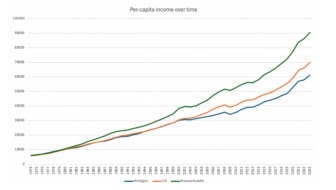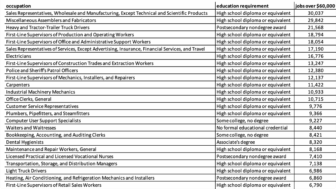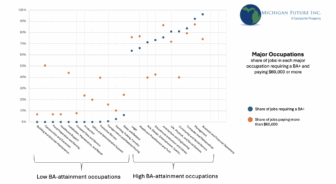
We have proposed a big Earned Income Tax Credit expansion. Increasing the current state match from six percent to 60 of the federal credit. Doing so would increase the average state credit from $150 to $1,500.
To us it is clear, as evidenced by nearly four in ten Michigan households unable to pay for basic necessities in our robust 2019 economy, that mid-course adjustment in what we have been doing is not the path to achieving a rising income for all. Rather we should identify the state policy levers that can have the highest impact on ending Michigan’s two-tier economy, And then go big in pivoting to a new approach to building a market economy that as it grows benefits all.
Starting with a big expansion of the Earned Income Tax Credit. For Michigan to move from the bottom to the top of state’s Earned Income Tax Credits.
The EITC is pro work and an incentive to go back to work. Nearly six in ten Michigan jobs pay less than what is required for a family of three to be middle class ($47,000). The pandemic made clear that these low-wage workers live paycheck to paycheck not because they are irresponsibly buying “unnecessary” luxuries, but because they are in low-wage jobs that leave them struggling to pay for the necessities. The reality is that most of those struggling economically, in good times and bad, are hard-working Michiganders who like us get up every day and work hard to earn a living.
What these lower-wage workers need most is income, not programs.
EITC Basics
The federal Earned Income Tax Credit was signed into law by President Gerald Ford in 1975. To encourage greater participation in the workforce, the EITC is based on earned income, such as salaries and wages. Workers receive the credit beginning with their first dollar of earned income; the amount of the credit rises with earned income until it reaches a maximum level and then begins to phase out at higher income levels. The EITC is “refundable,” which means that if it exceeds a low-wage worker’s income tax liability, the IRS will refund the balance.
Michigan enacted a state EITC in 2006 at 20% of the federal credit. In 2011 the Michigan EITC was reduced to 6% of the federal credit. In 2019 738,000 Michigan households received the state EITC with an average benefit of $150. At a cost of $111 million.
Thirty states plus D.C. offer state EITCs. Of the states with refundable credits and a match for the federal credit, Michigan has the fourth lowest match. The highest match is 85 percent in California but only for very low-income earners. Of the states with a match for all federal EITC eligible households Maryland currently has the highest match at 45 percent. D.C. has the highest match for childless households at 100 percent.
The EITC Benefits Business
In a The Hill column entitled To cut poverty and solve the labor shortage, enhance the Earned Income Tax Credit Kevin Seifert, vice president of the American Idea Foundation, a nonprofit headed by former Speaker of the House Paul Ryan, writes:
Since 1975, the Earned Income Tax Credit has proven to be one of the federal government’s most effective poverty-fighting programs and enhancing the credit is one of the best ways Congress can ensure a strong, bottom-up recovery from the pandemic. A common-sense expansion of the EITC is precisely the medicine the U.S. economy needs to return to full health.
… For millions of Americans with lower-incomes, because of the Earned Income Tax Credit, the more they earn, the larger the benefit they receive. The EITC’s intentional design not only helps employers and their employees but it directly aids families and their children as well. The benefit helps society’s most vulnerable and because it is tied to earnings, it reinforces the values that come with a steady paycheck.
Seifert is right when he writes that the EITC benefits workers, their families and employers. The benefits to workers and their families are obvious, not so obvious are the benefits to employers. So let’s delve deeper into the benefits to business from a big Earned Income Tax Credit expansion.
Encouraging Working
The EITC is explicitly designed to encourage greater participation in the workforce. The EITC is available only to families that work. The credit is designed to encourage individuals to enter the labor market. In a time when many employers are having difficulty filling available jobs, the EITC has a proven track record of pulling people into the workforce.
In a comprehensive 2020 study on the employment effects of the EITC Diane Whitmore Schanzenbach and Michael R. Strain found:
The Earned Income Tax Credit (EITC) is the cornerstone anti-poverty policy in the United States. Designed to fight poverty by encouraging and rewarding work, decades of research on the EITC has found that the program meets its goals by increasing employment among targeted women, and by successfully raising their annual incomes, lifting millions of families out of poverty. This paper confirms and extends that consensus.
Increasing Local Purchasing Power
The EITC provides income to be spent in the local economy. The bigger the credit the more money spent locally. Research indicates that families mostly use the EITC to pay for necessities, repair homes, maintain vehicles that are needed to commute to work, and in some cases, obtain additional education or training to boost their employability and earning power.
The Michigan League for Public Policy provides county level data on the additional purchasing power generated by the EITC. For example, in Kent County 44,000 households (14 percent) received the EITC in 2019 at an average federal credit of $2,367 and average state credit of $142. The combined state and federal credits increased recipient’s purchasing power by $111 million. Raising the state tax credit to a 60 percent match would add another $63 million in purchasing power to the families of hard-working Kent County residents.
Now is the time to go big
The EITC is a proven way to combat a two tier economy, boost local economies and pull people into the workforce. And all of this can be done with little or no additional administrative costs. Now is the time for Michigan to move from the bottom to the top of state’s Earned Income Tax Credits.







